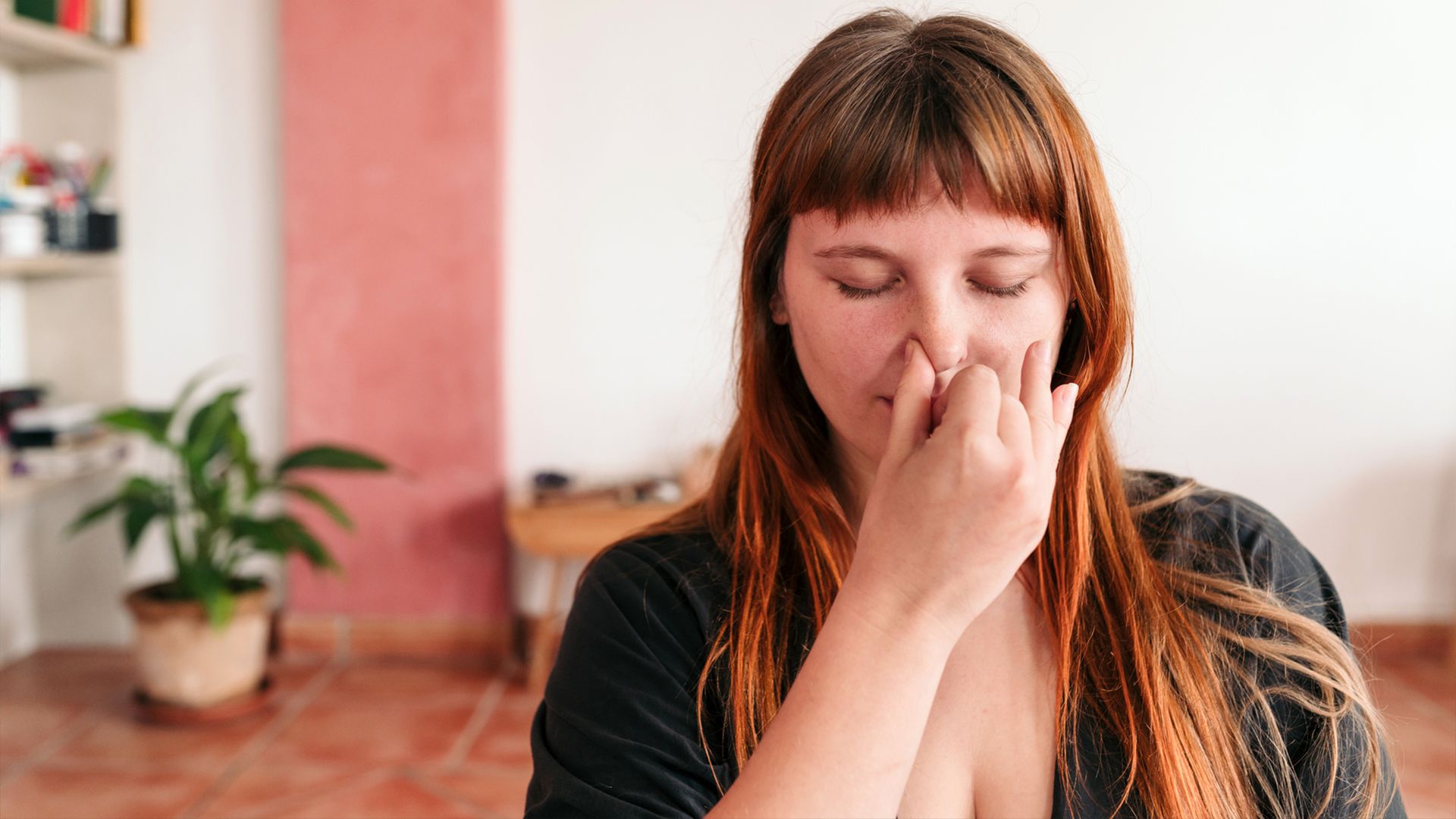The air that fills your lungs is an essential life force. It’s also a secret weapon for your well-being.
It’s estimated that the average person takes approximately 17,000 breaths a day, without ever really thinking about this vital life process. Since it’s an involuntary function, why would we? With all of our endless to-do lists and busy schedules, it’s nice to have the body take care of something on its own.
But here’s the thing: When we take voluntary control over this involuntary process using a tool called breathwork, breathing becomes so much more than bringing air into the body and forcing it out. Focusing on the cadence of our breaths can be downright therapeutic, both emotionally and physically.
“I first experienced breathwork when I was in my early twenties,” Grace MacLeod, founder of Graceful Living Coaching & Mentoring, tells DailyOM. “During an extended breathwork session, I had what can only be called a life-changing awakening. I use my practice every day for myself and consider it the ‘gold in my pocket’ that I am as passionate about sharing now, 40 years later, as I was when I first experienced it.”
DailyOM asked pros in the field about the practice’s rich history and benefits. Keep reading to learn more, including why you should keep these techniques as the gold in your pocket.
What Is Breathwork?
Breathwork is the exercise of consciously controlling your breathing as a therapeutic technique. It’s often used as a way to calm the mind and body, but it offers other benefits as well. There are different methods of breathwork, each with their own objective of targeting a specific need. These may include physical relaxation, de-escalating from a stressful situation, or energizing oneself both physically and mentally.
Interested in learning more? Check out Guided Relaxation With Ocean Sounds
The History of Breathwork
Controlled breathing dates back to ancient times when it was often incorporated into yoga, martial arts, and Buddhist practices (it can be traced to other religions as well). It was used in healing rituals and as a method for centering the mind.
In the 1960s and ’70s, a modern approach to breathwork came to the Western world and is largely attributed to the teachings of two pioneers in the field. Psychiatrist Stanislav Grof is credited with developing what is known as holotropic breathwork. He applied it as a way to alter a patient’s state of consciousness without the use of drugs. Meanwhile, in New York, longtime yogi Leonard Orr discovered what is known as rebirthing breathwork, a connected breathing technique. He later penned numerous books on self-discovery, including Rebirthing in the New Age.
These two new approaches to breathwork made way for the practice’s increased rise in popularity.
The Science of Breathwork
“You can survive approximately a week without food, a few days without water, but only a few minutes without air,” says Kelly Kessler, DPT, owner of Optimal You Health and Wellness. “However, when most people think about improving their health, diet and exercise are typically the methods that are pursued. But breath is a powerful tool that yields many benefits for emotional, mental, and physical well-being.”
Dr. Kessler points out that everything that keeps us alive and balanced is controlled by the autonomic nervous system. Heart rate, blood pressure, and digestion are just a few of these. Of the many processes this system controls, breathing is the one function that is both voluntary and involuntary.
“Breath is a powerful tool that yields many benefits for emotional, mental, and physical well-being.”
Breathwork can be used to regulate the degree to which sympathetic and parasympathetic systems are activated. The sympathetic nervous system is the nerve network that activates our fight-or-flight response. The parasympathetic nervous system is in charge of relaxing the body in times of distress. With that in mind, knowing how to control your breath in ways that either quell or trigger these systems is incredibly helpful.
A study published in Frontiers in Human Neuroscience found evidence that slow breathing techniques lend themselves to what the researchers described as cerebral and psychological “flexibility.” This flexibility allows for better emotional control and overall psychological well-being.
Why Is Breathwork So Popular Now?
MacLeod has seen the popularity of breathwork rise and fall in waves over the four decades she has been practicing and teaching. She attributes its latest swell to the chronic and overwhelming stress many have been experiencing during the crises of the last several years. People are discovering breathwork to be a convenient form of self-care.
“It is simple and can be practiced anywhere,” MacLeod says. “The advent of breathing apps has allowed people to have a readily available practice that can be applied right when it is needed.”
She speaks of high-level executives who practice breathwork while flying to conferences or commuting to work. Then there are new mothers who use the practice while breastfeeding or putting their babies to sleep, and partners who use breathwork to connect with each other.
“I have worked with couples who were in such deep pain and discord that they could not talk,” MacLeod shares. “They agreed to a simple breathwork practice together, and after finding their own inner balance, agreed to synchronize their breathing. The defenses melted, their hearts opened, and they were able to continue on to integrate the pain and come back into connection.”
As LaCriscia Fowlkes, an independent researcher, points out in a paper published in The Journal of Contemplative Inquiry, the need for breathwork in BIPOC communities was made abundantly clear in 2020. Not only was COVID-19 ravaging the world, but systemic and societal issues surrounding race and anti-Black violence were finally front and center. Fowlkes, a holistic practitioner herself, encourages the inclusion of Black music in breathwork practices as a method for making the exercise more inclusive to those who can certainly benefit from its effects. Indeed, organizations such as Black Girls Breathing was born out of the need for a supportive community in which Black women can address their mental health with the help of breathwork. This is a vital form of self-care that often doesn’t reach underserved communities.
The Emotional Benefits of Breathwork
When you learn to control your breathing, the benefits feel priceless. In terms of emotional support, Kessler says that by shifting the nervous system into a rest-digest-restore state, feelings of stress and anxiety start to diminish. “Breathwork also improves clarity of thought, concentration, and overall memory,” she adds.
The practice is also helpful in building confidence and mastering emotions. “When breathwork is practiced in a gentle way with the proper guidance and support, we learn to recognize and be with our emotions literally one breath at a time,” MacLeod says. “We recognize the heavy states of buried or blocked emotions. We see how they arise in the body and mind. Then we learn to meet them, trust them, and discover that they are simply waves of energy with wise messages for us.”
The Physical Benefits of Breathwork
At first glance it might be difficult to see how breathwork can have physical benefits as well as emotional ones. But many students of the practice see decreased muscle tension and inflammatory response. Breathwork can also improve circulation and reduce pain sensitivity, which is why many pregnant people practice Lamaze breathing before and during childbirth.
“Practicing breathwork also shifts the body into a mode of restoration in which it is able to heal and repair tissues,” says Kessler. “Conversely, when the body is in a stress response, the body is more focused on survival rather than restoring and repairing itself. Breathwork is a powerful avenue for allowing the body to make this shift.”
The Different Types of Breathwork
Breathwork can be a deeply personal practice. There are online options for those who would like to remain in the comfort of their home. If you like the idea of a communal setting, there are in-person classes available as well; a simple internet search for “breathwork classes near me” will help you locate centers and practitioners nearby.
Once you start exploring breathwork, you’ll find that there are many different techniques, including holotropic breathwork, revelation breathwork, shamaic breathwork, transformational breathwork, pause breathwork, and vitality breathwork. But the most simple of these is breathing with focused awareness, something we often do during meditation. When you pay attention and observe your breath, it will often regulate on its own.
Listen: DailyOM Guided Breathwork by Kelly Smith
4 Popular Beginner-Friendly Breathwork Techniques
1. Box Breathing
This deep-breathing exercise has you count to four as you breathe in, hold that breath for a count of four, release the breath on the four-count, then finally hold again for four counts. Then repeat this entire four-part, four-count series.
2. 4-7-8 Breathing
For this exercise, you will inhale for four counts, hold for a count of seven, then exhale for a count of eight. Repeat.
3. Alternate Nostril Breathing
For this technique, close one nostril during your inhale and then close your alternate nostril for the exhale.
4. Humming Breath
Quite simply, humming breath is when you breathe in and then hum on the exhale with your mouth closed.
These four exercises are used among different practices of breathwork, which include holotropic, rebirthing, vivation, transformational, clarity, and shamanic.
Things to Consider Before You Start Breathwork
In general, breathwork is a safe and effective way to help regulate stress and calm the mind. However, there are some things to consider to ensure your practice doesn’t have any negative effects.
Begin with simple, straightforward breathing exercises, such as the ones listed above. There are more challenging breathwork techniques that, in some cases, can lead to hyperventilation, dizziness, and tingling sensations that detract from what you are trying to accomplish, which is overall wellness.
If any breathing technique, no matter what kind, results in increased anxiety, shortness of breath, or discomfort, do not continue the exercise. Stop and return to breathing normally, allowing that involuntary process to take over again.
The Bottom Line
Breathwork is having a moment because it is an easy and affordable form of self-care available to all of us. You can use these simple techniques to manage stress discreetly no matter where you are: the car, the office, even the grocery store.
The benefits of breathwork can be powerful — and can help you breathe a little easier at the end of the day.

